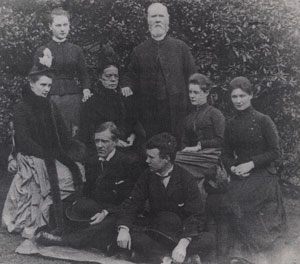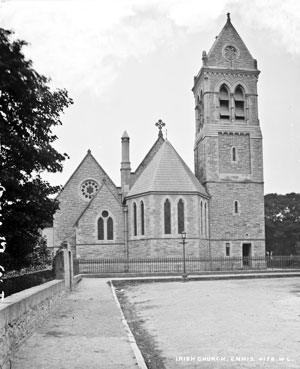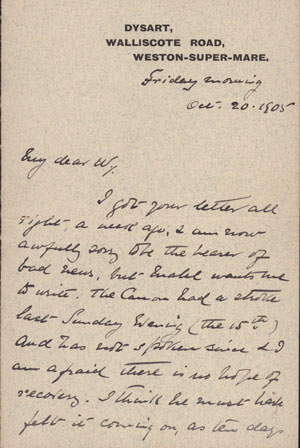THE CANON DWYER COLLECTION
Published in Issue 1 (January/February 2023), Volume 31By Rene Franklin Lynch

Above: Canon Dwyer c. 1883 with his wife Anne, daughters Mabel (standing), Mary, Charlotte and Annie (sitting), and sons Harry(?) and William (front). (Clare County Archives)
The Canon Dwyer Collection of letters, written between 1884 and 1919, conveys a vivid account of a Clare family split by emigration, the changing role of women and encounters with and experiences of historic events. In a letter dated 14 December 1905, Mary Bethune wrote to her brother, William Dwyer of Vancouver Island, concerning their father’s death: ‘[he] died so peacefully and happily without pain and so many of us around him …’. Her father was Canon Philip Dwyer (1822–1905), who in 1883 resigned as rector of St Columba’s Church of Ireland church, Ennis, where he had served since 1864, and moved his family of three sons and five daughters with his wife Anne (née Stather Crowe of Ennis) to serve in Vancouver Island. From August 1883 to September 1884 the canon was attached to Christchurch Cathedral in Victoria, and in 1885 he was living in Chemainus, Vancouver Island, in charge of the Chemainus and Saltspring Mission.
Canon Dwyer had made significant contributions to his parish before his departure from Ennis. The Clare Freeman reported in 1865: ‘The Rev. Mr. Dwyer informed his congregation that he had written to the Ecclesiastical Commissioners to ascertain their views on the proposed extension of their church at the Abbey which was too small for the congregation since their other churches at the parish had been closed’. In 1867 it was decided to build a new Protestant church in the town of Ennis and by 1870 Canon Dwyer had collected £8,000 towards the building fund. The new church opened in 1871 with a capacity of 450. This beautiful building remains one of the finest ecclesiastical edifices in County Clare. Canon Dwyer was the author of The diocese of Killaloe from the Reformation to the close of the eighteenth century (1878), which is considered one of the first modern diocesan histories and gained him a reputation as the ‘historian of Clare’. He also pseudonymously published A hand book to Lisdoonvarna and its vicinity (1876) and other books relating to the county.
In a letter to her fiancé, Lt. Harry Bethune, Mary Dwyer describes the harsh working conditions that her father endured while on duty: ‘he was for eight or ten hours at a stretch in the saddle and generally wet through and sometimes his horse … almost up to its neck in the snow … then he had to pull himself for five miles in an old leaking boat to get to Salt Spring Island. And the only place he could stay was with an old Indian, he had to sleep on a bundle of straw and got nothing to eat but potatoes and tea without milk!’ (3 April 1886). Though often reminiscing fondly about Ireland, she was aware that they would not return: ‘We ought [to be] thankful we are out of poor dear Ireland, as it is more disturbed than ever, several people we know have been shot at and boycotted they are even shooting and boycotting women, and the cruelty to animals is something fearful, I can’t bear to read about it’ (October 1885).

Above: By 1870 Canon Philip Dwyer had collected £8,000 towards the building of a new church in Ennis, St Columba’s, which remains one of the finest ecclesiastical edifices in County Clare. (NLI)
By 1885 Canon Dwyer’s daughter Fenella had married a Revd Malachi and left British Columbia for Scotland. The rest of the family remained in Victoria, Vancouver Island, for two more years, but passages from letters demonstrate that they wished to leave. In July 1886 Mary writes that her father ‘can get work in Ireland but is trying more to get it in England, but if he is not successful he will go to the North of Ireland’.
By 1888 the family had moved to England, where Mary married Captain Harry L. Bethune (1858–1939) in St Mary’s Church, Sowerby, West Yorkshire. Her sister Charlotte married a Captain Jones, and within a year another sister, Annie, had married Selwyn Rawson, a wealthy industrialist.

Above: The first page of Selwyn Rawson’s letter of 20 October 1905 to Canon Dwyer’s son William, informing him of his father’s stroke—‘… after supper the Canon was relating some of his Irish reminiscences when he began to stammer badly and then lost his speech …’. (Clare County Archives)
At the time of his marriage to Mary, Harry Bethune was serving on HMS Mercury. It was during his voyages that a number of the collection’s letters originated, giving a firsthand account of their lives and those of their family and of the society of that time. They had three children, Charles Phillip (b. 1889), Rupert Edward Maximilian (b. 1896) and Dorothy Anne Frances (b. 1892). Lt.-Commander Rupert Edward Maximilian Bethune served during the First World War and earned the Distinguished Service Cross at the first landing at Gallipoli. Sadly, he died during the ’flu epidemic of 1919. Dorothy was educated at the Royal Naval College for girls and then Cardiff University, where she studied medicine. She gave up the degree to nurse behind the trenches during the First World War. Upon her death in 1935, the Halifax Evening Courier described her as a ‘prominent political and social worker’.
Canon Dwyer, on his return to England, was a supply priest until the 1890s in Leicestershire, Somerset and Norfolk. He never returned to Ireland, though ironically it was of Ireland that he spoke his final words. In a letter dated 20 October 1905 to the canon’s son William, Selwyn Rawson wrote: ‘The Canon had asked his daughters to visit him ten days beforehand … after supper the Canon was relating some of his Irish reminiscences when he began to stammer badly and then lost his speech … I will write you next mail unless someone else does, and let you know how things are going, but I am afraid the worst will have to be told.’ Canon Dwyer died soon after.
Mabel, the youngest daughter of Canon Dwyer, never married and remained living with her mother in Weston-super-Mare, Somerset. Mabel’s letters document the personalities of her extended family; she gives significant glimpses into the life of her brother William and his wife, Mary ‘Molly’ (née Lomas), who remained for their lifetimes in Vancouver, where they had two sons and five daughters. During his career William worked as an aerial tramway foreman at the Mount Sicker copper-mines, a local returning officer in federal and provincial elections, school chairman of the First Duncan School Board and Duncan North Cowichan consolidation, and president of the Cowichan Historical Society.
The Canon Dwyer Collection of letters and photographs was donated on behalf of the Dwyer descendants by Prof. Deirdre Hunt, great-granddaughter of Canon Dwyer, and is available to view at www.clarelibrary.ie/eolas/photographic_archive_collections.htm.
Rene Franklin Lynch is an archivist with Clare County Council.
















